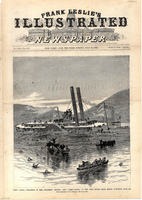 | Back to e-WV
| Back to e-WV
 The West Virginia Encyclopedia
The West Virginia Encyclopedia
 | Back to e-WV
| Back to e-WV
 The West Virginia Encyclopedia
The West Virginia Encyclopedia

At 8:30 p.m. on July 4, 1882, steamboats Scioto and John Lomas collided on the Ohio River as they were returning from holiday excursions. The Wellsville (Ohio) Coronet Band had chartered the Scioto to take paying guests to Moundsville from East Liverpool, Wellsville and other communities along the river while the John Lomas carried a group returning from a dinner in Steubenville.
The pilot of the John Lomas, steaming south near the Ohio shore near Mingo Island, saw the Scioto ascending the river along the West Virginia bank. Acting in accordance with steamboat rules for passing boats that had become effective just days before, the pilot blew his whistle to indicate that he would remain on his course and allow the Scioto to pass on his left. The Scioto pilot responded with his own whistle to claim the Ohio shore based on customary, but contrary, procedures for passing another boat at that specific spot in the river. The boats were too close to change direction before colliding.
The Scioto was severely damaged and sank almost instantly in 15 feet of water about 200 feet from the Ohio shore. The relatively unscathed John Lomas, joined by small boats launched from both the Ohio and West Virginia riverbanks, began an immediate rescue effort, but more than 70 people from the Scioto drowned. The Scioto, which normally carried no more than 60 passengers, had secured a permit for 300 and actually had more than 500 on board. Dangerously overloaded, the boat was difficult to steer, and the subsequent investigation discovered that the Scioto pilot had been drinking on the trip, was possibly intoxicated, and had allowed an unauthorized person to steer the boat.
The pilot of the Scioto, David C. Keller, was indicted and tried for manslaughter before Judge John Jay Jackson Jr. in federal court in Parkersburg. The 1838 law that created the Steamboat Inspection Service, one of the first instances of federal regulation of private enterprise, provided for the inspection of steamboats and steam boilers and for licensing pilots and captains. It also allowed the prosecution of boat officers whose negligence resulted in loss of life. Keller’s first trial ended in a hung jury in the summer of 1883 because of controversy over which rules applied for passing boats on the Ohio River. Judge Jackson, incensed by newspaper articles influencing jurors in the 1883 trial, issued a “gag” order limiting what newspapers could report before the second trial began. Keller was convicted in February 1884 and sentenced to two years in jail and a $500 fine. He was pardoned by President Grover Cleveland in November 1885, regained his pilot’s license, and resumed work on the river. With Keller’s pardon, no one was deemed responsible for the deaths of more than 70 people.
Written by Kenneth R. Bailey
Kenneth Bailey. The Scioto Disaster. West Virginia History, 6, 1, Spring 2012.